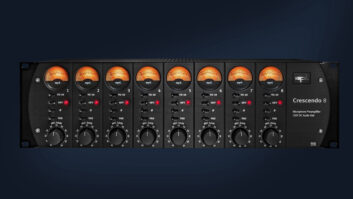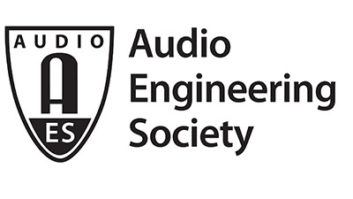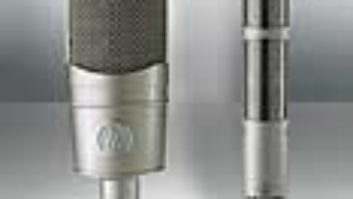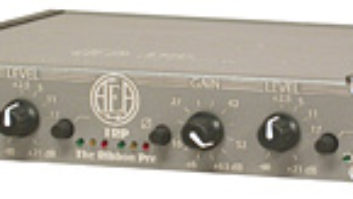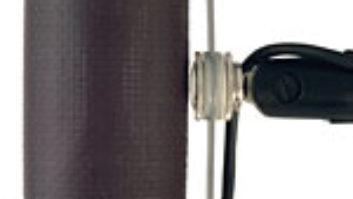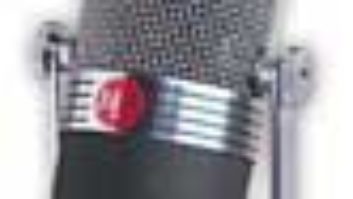Your sound = the room + your mics + your electronics. Classic studio ribbon microphone designs have no powered internal electronics, just the ribbon, magnets, and a step-up transformer with perhaps a passive Hi-Pass filter network and an output cable. You make all the decisions about the sound of the signal chain. You don’t think this is important? Look at the difference in price and desirability between the Neumann tube U67 and solid state U87 microphones. The shape and capsule are substantially the same, but the electronics are different and that makes all the difference. With classic studio ribbons, you call the shots and choose which preamp’s sonic signature works best during each phase of a project.
The price of this freedom is the need ribbons have for more external mic preamp gain when micing soft sound sources or working at a distance. Many contemporary microphone preamp designers have become accustomed to relying on condenser microphones’ internal electronics to supply the first 10-15 dB of gain for the system. As a result, their preamps do not provide sufficient clean, quiet gain to optimally support ribbon microphones.
A study of the noise and gain structure of mic preamps fed by condenser mics showed that after a mic preamp reached an Equivalent Input Noise (EIN) of -125 dB, then the external electronics in the condenser mic actually determined the noise floor. The EIN limit for mic preamps fed by a 150 ohm source impedance is about -131 dB; thus, condenser mics have eased the mic preamp designer’s task by about 6 dB.
Equally important in the design of the microphone preamp is the terminating impedance it presents to the microphone. (More about this below at Microphones get loaded.)
Preserving the sound quality achieved by “classic” ribbon microphones, such as the RCA 44, 77, and Coles 4038, provides deep emotional satisfaction to a mic preamp designer – especially one who strives to achieve a low noise floor and pays attention to how the mic preamp sounds at higher gains as well. Rupert Neve and other careful and considerate mic preamp designers maintain consistent preamp sound quality at both low and high gains. For consoles that have a large number of internal mic preamps, this is an expensive capability that is often ignored. Luckily, there are a number of specialist manufacturers who still handle these design compromises well and offer minimalist high-gain performance with switchable phantom-power to accommodate engineers using ribbon microphones.
History Revisited Several ribbon microphone designs in the past 50 years have included internal electronics and met with mild success. The limitations of this approach are twofold. One is purely subjective: you now have to accept the sonics inherent to a particular audio circuit design. These compromises might not always fit your music best. The other is based on the practical limitations of electronic circuitry i.e., the ability to accommodate the wide dynamic range inherent in music recording.
Ribbon mics can handle extreme SPLs at high frequencies and this makes them a natural for close up use on brass and percussion. At the same time, they are uniquely sensitive to very soft, delicate sounds, such as stringed instruments. Thus, they produce a very wide, useable dynamic range without active sources of distortion and noise.
Inherent in the international specifications for phantom-power supplies are limits to the current and voltage available for phantom-powered mic electronics. The dilemma facing designers of phantom-powered electronics for ribbon mics is this one. When there is enough gain to bring a ribbon up to match a typical condenser mic’s sensitivity, these phantom powered internal electronics will clip at 1 kHz and above long before the ribbon itself starts distorting.
External gain switching which Neumann and many other makers provide is one way to design around this. Unfortunately there is no convenient way to know how often the internal electronics are clipping and that the gain needs to be changed. In contrast, almost all external preamps and console input channels have highly visible overload LED indicators and a gain control to eliminate clipping.
Which electronics are best for ribbon microphones? In some situations we feel that internal active electronics can be quite useful. For most applications we feel that high quality external mic preamps are the best choice. They offer easy control of both dynamics and tone color and can be used with any of your microphones. Excellent single channel designs start at around $700 and your choices multiply amazingly as you get to the $1,000 per channel level.
Microphone choice and placement is the most critical decision you make. The next major quest is to find appropriate and complimentary mic preamps. These can make an enormous contribution to your sound. The particular mic and electronics you choose is very much a matter of style. It can change from one piece of music or instrument to another. However by being able to mix and match mics and electronics, your pursuit of the sound you want is less restricted. Ribbon mics are known for being smooth and versatile performers that sound good on a wide variety of music. That universality is why 70 year old ribbon mic technology is still in daily use at cutting-edge studios along with 50 year old microphone preamps.
Microphone output loading: In a 1955 AES Journal article, Richard Werner of RCA showed how a mic’s frequency response is altered by changes in its mic preamp’s input impedance. He measured how a mic’s output impedance vs. frequency interacted with the input impedance vs. frequency of different mic preamps. In 1985 AEA introduced the MS380TX transformer coupled stereo mic preamp and MS matrix. It had a switch to optimize the match between a mic’s output impedance and the preamp’s input transformers. Recording engineers told us this switch was useful as a creative tool to vary the tone color. There are now a number of mic preamp designs that offer a choice of preamp input impedance. What’s going on here?
There are two important aspects of the load a mic preamp presents to a microphone. The first is what it does to the mic’s headroom and the second is what it does to the mic’s frequency and transient response. Balanced output professional microphones have source impedances that vary from down around 20 ohms to up around 300 ohms, with a few all the way up at 600 ohms. These all are considered low impedances and help minimize both hum pickup and the loss of high frequencies caused by longer lengths of mic cable.
Variable input impedance mic preamps alter the loading and sonic character of a microphone. They can change the resistive loading presented to the mic and/or they can change the turns ratio (impedance transformation) of the input transformer. The sonics of the latter, which can change the impedance vs. frequency load, can be quite complex .
Remember:
1. The lower impedance a mic must drive, the harder it has to work. Too low an impedance loading a mic is heard as increased distortion and decreased headroom.
2. Changing the turns ratio and secondary loading of a good transformer being driven by a microphone will change a mic’s sound on transients from dull to open to ringing.
The challenge is sorting out which changes are better and which are they just different.
About mic preamp input impedance: To hear a microphone as the designer intended it, load it across the audio band with an input impedance of at least 1,500 ohms. Above and below the audio band, the impedance should also stay consistent and high. The general rule is that the load impedance a mic sees should be five or more times the mic’s own source impedance. For a 300 ohm mic such as the Coles 4038, this would translate to 1,500 ohms. For a 150 ohm source mic such as most Neumann mics, this would mean a minimum load of 750 ohms. However at this low impedance a condenser mic’s electronics can be working very hard when things get loud. They can sound significantly different with a higher input impedance mic preamp.
Transformer coupled mic preamps typically have contribute more sound “character” than current transformerless designs. Perhaps this is why the best transformerless designs are consistently described as “open” and “neutral”. Transformer coupling presents a much more complex set of variables. Not only do transformers contribute their own sound, but that sound changes when the impedance feeding their primary (input) side changes, when the turns ratio changes, and when the load on the transformer’s output side (secondary) changes.
Varying the source or the load characteristics, or the turns ratio of a mic preamp’s input transformer, changes the preamp’s overall sound in quite complex ways. It alters both the 20-20kHz audio-band frequency response and the frequency response above and below those points that so strongly impacts a preamp’s overall character and transient response. These transformations in the sound of a mic preamp are deviations from linearity. They are another form of signal processing that can lend interesting color options to your recording. Only you can determine if these changes hold up through repeated listening.
